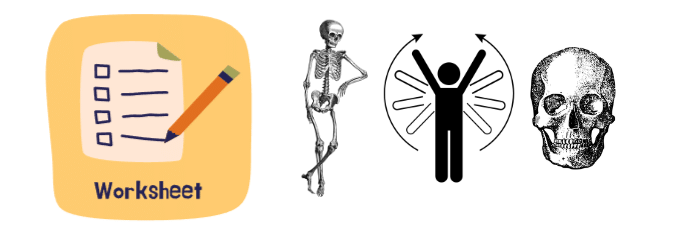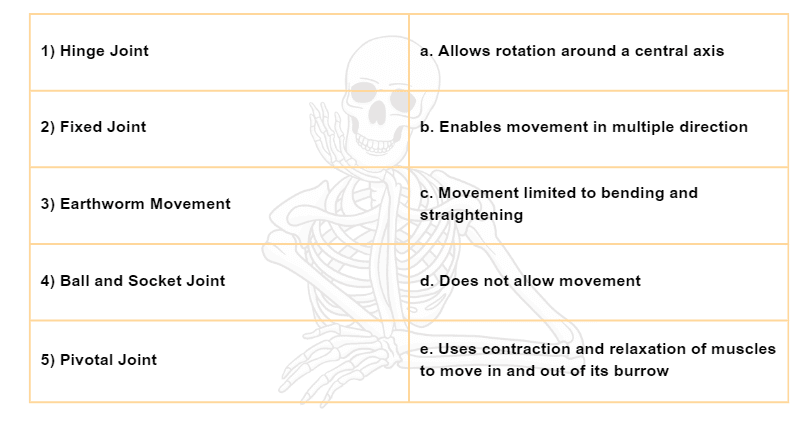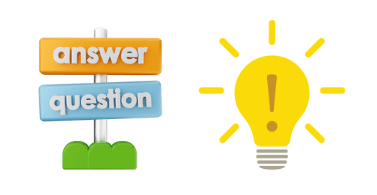Body Movements Class 6 Worksheet Science
Q1: Fill in the Blanks
i. We are able to bend or rotate our body only at .ii. Bones and forms skeleton of the human body.
iii. gives frame and shape to our body and helps in movement.
iv. In a joint a cylindrical bone rotates in a ring.

v. images are used to find out about any possible injuries that might have happened to the bones.
vi. protects brain.
vii. Our skeleton is made up of many , joints and cartilage.
viii. The rounded structure a snail carries on its back is called .
ix. on the body of fish mainly helps to keep the balance of their body.
x. Snakes have a backbone.
xi. Snails move with the help of a .
Q2: Match the Following

Q3: True or False
i. Bones cannot be bent.
ii. Hinge Joint allows movement in all directions.
iii. The elbow has a fixed joint.
iv. The bone in our arm is joined to our shoulder by a ball-and-socket joint.
v. The joint between the upper jaw and the rest of the head is moveable.

vi. Bones in our body form a framework to give shape to our body. This framework is known as the skeleton.
vii. Ribs join the chest bone and backbone together to form a box called a skeleton.
viii. The skull is made of many bones joined together.
ix. Cartilage is also found in the joints of the body.
x. Cockroaches have three pairs of wings attached to the breast.
xi. The snake moves forward very fast and not in a straight line.
Answer the following
Q4: Write names of two animals that can move without bones.
Q5: Write three animals that have streamlined bodies.
Q6: Name one animal which can walk and climb as well as fly in the air.
Q7: Name two birds that can swim in water.
Q8: Name an aquatic animal whose skeleton is made entirely of cartilages.
Q9: Where is cartilage found?
Q10: What is a cavity in bones?
Q11: Which organs are protected by the rib cage?
Q12: What are ribs?
Q13: What is a skull?
Q14: Name the organ that helps cockroaches in walking.
Q15: What is a bone?
Q16: Is it possible for us to bend our bodies at every point?
Q17: If our body has no joints then will it be possible for us to move?
Q18: What would have happened if our body was made of single bone?
Q19: Which type of joint is used when a cricket bowler balls the ball?
Q20: What type of joint is used while lifting weights?
Q21: How many bones are present in our skull?

Assertion and Reason Questions
Q22: Assertion (A): Entire skeleton of shark is made of cartilage.
Reason (R): Cartilage is also found in joints in body.
(a) Both A and R are true and R is the correct explanation of A.
(b) Both A and R are true but R is not the correct explanation of A.
(c) A is true but R is false.
(d) A is false but R is true.
Q23: Assertion (A): Shoulder is the region where fore limb or arm joins the body.
Reason (R): The two bones at the shoulder are called shoulder bones.
(a) Both A and R are true and R is the correct explanation of A.
(b) Both A and R are true but R is not the correct explanation of A.
(c) A is true but R is false.
(d) A is false but R is true.
Q24: Assertion (A): Earthworm has muscles that help to extend or shorten body.
Reason (R): Muscles can only pull and not push.
(a) Both A and R are true and R is the correct explanation of A.
(b) Both A and R are true but R is not the correct explanation of A.
(c) A is true but R is false.
(d) A is false but R is true.
Q25: Assertion (A): Cartilage covers the ends of bones.
Reason (R): Cartilage acts as a shock absorber and reduces friction between bones.
(a) Both A and R are true and R is the correct explanation of A.
(b) Both A and R are true but R is not the correct explanation of A.
(c) A is true but R is false.
(d) A is false but R is true.
You can access the solutions to this worksheet here.
FAQs on Body Movements Class 6 Worksheet Science
| 1. What are the different types of body movements? |  |
| 2. How do muscles play a role in body movements? |  |
| 3. Why is it important to have a good range of motion in the body? |  |
| 4. How can one improve their body movements and flexibility? |  |
| 5. What are some common factors that can affect body movements? |  |

















